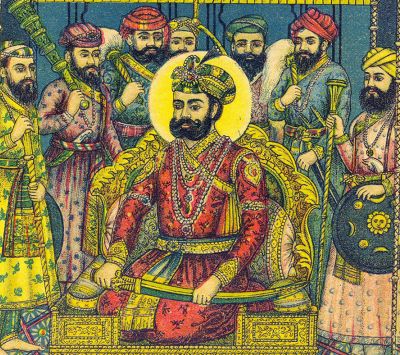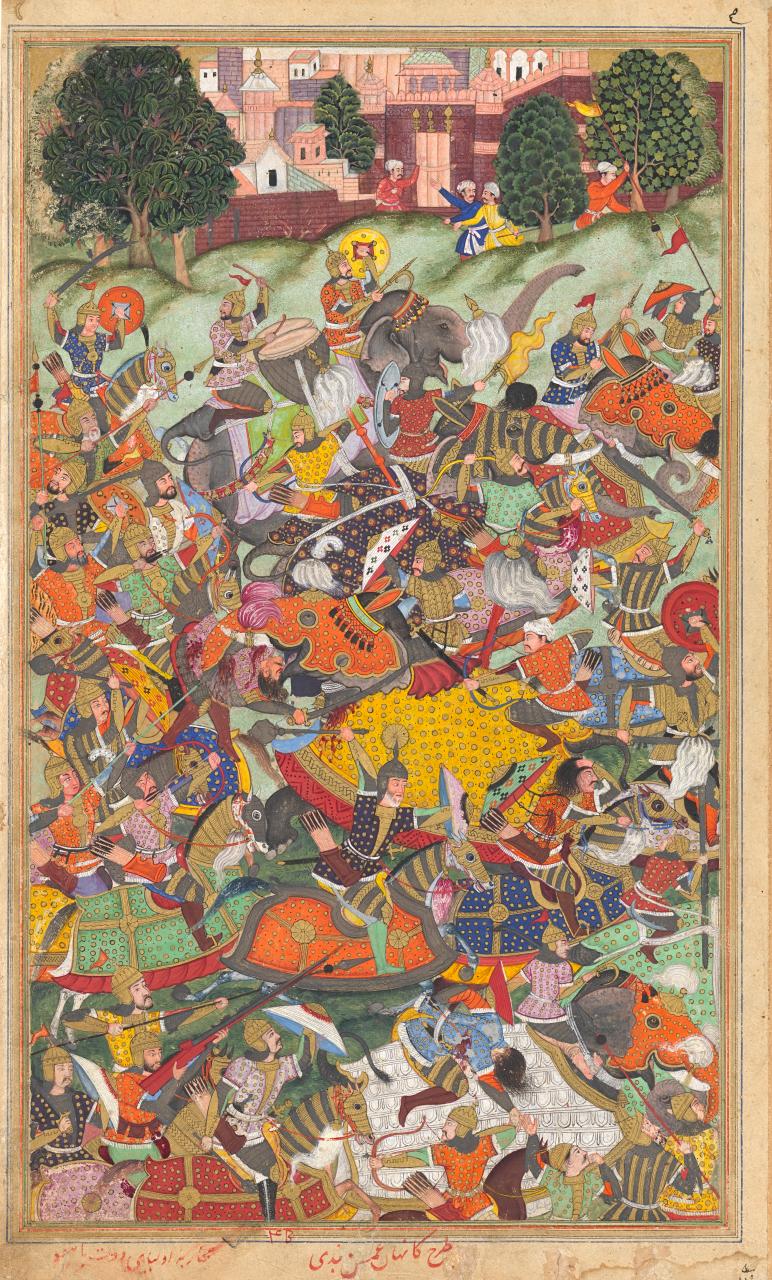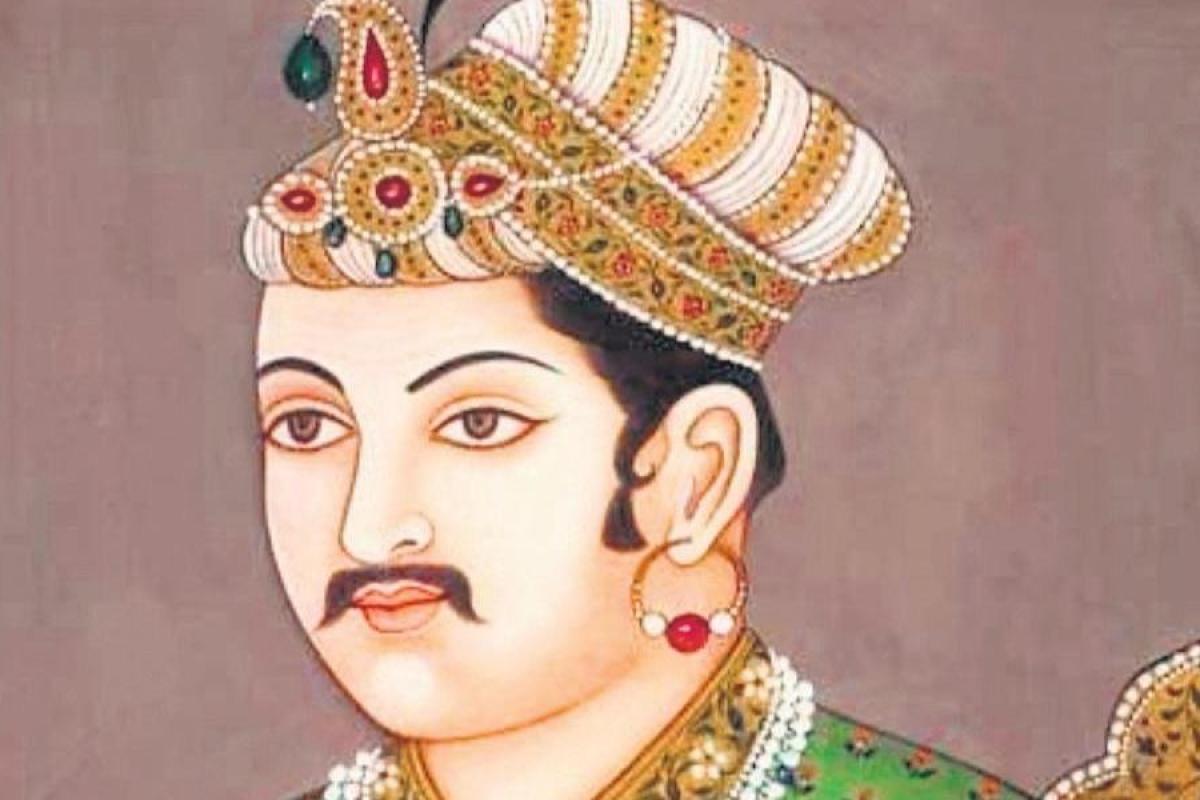After the Humayun, Akbar took the throne. But before that Humayun put his best effort to regain the empire back from the Suri Dynasty. The Battle of Machhiwara took place on 15 May 1555 A.D. between the Afghans and the Mughals. It was a complete victory for the Mughals and the entire Panjab was occupied by them. Sikandar Shah himself then marched forward to fight against the Mughals and the battle of Sirhind was fought between the two on 22 June 1555 A.D.

Sikandar Shah was defeated and fled to the hills of north-west Punjab. Humayun then occupied Delhi in July 1555 A.D. Afterwards, Agra, Sambhal, and the nearby territory were also occupied by the Mughals.
Humayun, however, could not live long after the capture of Delhi. One day when he was descending from the stairs of the library at Din Panah, he slipped and fractured his skull. Only two days after the accident, he died on 26 January 1556 A.D. He nominated his son Akbar as his successor to the throne before his death.
Jalaluddin Muhammad Akbar
Jalaluddin Muhammad Akbar who becomes famous as Akbar, the Great was the son and successor of the Mughal emperor Humayun and the grandson of Zahir-ud-din Muhammad Babur who laid the foundation of the Mughal Empire in India.
By the time Akbar was about to be born, Humayun had already lost his empire to Sher Shah and was wandering here and there as a fugitive with a small number of his followers. His wife Hamida Banu Begum, a Persian Shia lady, was also with him. She was by that time in the advanced stage of her pregnancy and was unable to move with her fugitive husband. Fortunately, she got shelter in the house of the King Rana Virsal of Amarkot (now known as Umerkot) who being moved by humanity and generosity assisted a king at his darkest hour of life.

Rana Virsal also assisted Humayun with men and material to enable him to lead an expedition against Thatta and Bakhar. When he was on the way of the expedition and while camping somewhere on the way, we got the news of the birth of his son from a trusted follower named Tardi Beg Khan. The child was born on 15th October 1542. It was joyful news for Humayun and his followers. He thanked the Almighty for his blessing. But as he was in a destitute condition he could not reward his followers in a befitting manner.
He did not take interest in literary education. Rather he was fond of martial arts and military education. Under the guidance of his teacher Bairam Khan, Akbar achieved skill in the display of sword and horse riding. Humayun had given Bairam Khan the entire responsibility of his son and had asked him to act as his guardian. Bairam Khan in-fact rendered this responsibility very honestly with a great sense of respect and devotion to his master Humayun.
Akbar was appointed as the Governor of Ghazani in 1551 after the death of his uncle Hindal. At Kabul, Humayun was waiting for an opportunity to score his goal in Hindustan. Sher Shah was succeeded by his son Islam Shah who died in 1553. After his death, the Shah domain was divided by some powerful aspirants such as Muhammad Shah Adil, Ibrahim Sur, and Sikandar Shah who owned Agra, Punjab, and Delhi respectively.
Humayun restored his Imperial throne of Delhi. On 23rd July 1555, he entered the capital and ascended the imperial throne. Akbar was assigned the governorship of Punjab and was also declared as the heir-apparent.
However, Humayun did not live long to enjoy the throne of Delhi. On 24th Jan. 1556 he met an accident while coming down the steps from his two-storeyed Library and died. Meanwhile, Akbar was at Punjab with his guardian Bairam Khan and was busy chasing the Sur emperor Sikandar Shah who was creating fresh problems for Mughals. When the news of the emperor’s death reached, Bairam Khan, who was a politician, declared Akbar as the new emperor and performed his accession ceremony in the garden of Kalanaur in Punjab on 14th February 1556.
This accession ceremony simply registered Akbar’s claim on the throne of Delhi. At Delhi, the news of the emperor’s death was not disclosed to the public for seventeen days as the prince Akbar had not reached the capital. A man named Mulla Bekasi who resembled Humayun was asked to appear from the Jharokha till Akbar was formally declared Emperor of Delhi.
Early Problems of Akbar
Humayun died leaving the throne of Delhi insecure and unstable. The Afghan ascendency was at its high point and Delhi passed to their hands when Hemu, the able prime minister of Adil Shah of Bengal attacked and captured Delhi sometimes in October 1556. By this time Akbar was at Jalandhar and was watching the fall of the Mughal control over its empire.

Mughal states like Bayana, Etawah, Sambhal, Kalpi, and Agra were not under strict control. Even the situation at Kabul, Kandahar, and Badakhshan was not in favor of the Mughals. Afghans like Sikandar Shah, Ibrahim Shah, and Adil Shah were still aspiring to establish their supremacy. Adil Shah was already successful in establishing his supremacy over the throne of Delhi through his able Commander Hemu. The Rajput States like Mewar, Ambar, and Jaisalmer were still powerful and posing threat to the rise of Mughals.
The Second Battle of Panipat (Nov. 2, 1556)
The loss of Delhi was a great blow to Akbar and the Mughals. Hemu after capturing Delhi assumed the title of Vikramaditya and had established his control over a vast territory spreading from Gwalior to the river Satluj. Akbar was advised by his terrified Mughal nobles and officers that it would not be wise to encounter an enemy like Hemu and we should return to Kabul for safety and reorganization. But Bairam Khan did not agree to this advice and decided to measure swords with Hemu.

Akbar also agreed with his regent. As a result, the armies of the Mughals and the Afghans met each other on the historic battlefield of Panipat on the 5th of November 1556. This is known as in history as the Second Battle of Panipat. Although Akbar had a small number of army about 20,000 under his command, it was a crucial battle for him. But the army of Hemu was more than five times than that of Akbar.
It was not the strength but courage and confidence that made Akbar face his greatest enemy boldly. It is said, fortune favors the brave. Hemu on the other hand despite a huge army was not favored by fortune. In the thick of the battle, an arrow struck him in his eye which pierced his brain. He fell unconscious on the battlefield.
His army being headless dispersed in confusion. Akbar won the battle and recovered the throne of Delhi. Hemu was captured and beheaded. Thereafter it came to an end to Afghan ascendency. The sun of the Mughal Empire began to ascend on the political horizon of India.
Regency of Bairam Khan
Bairam Khan as the guardian of Akbar continued as the de facto administrator of the Mughal Empire. But being power-drunk he grew proud, heedless, and autocratic. His high-handedness also came to the notice of the Akbar on many occasions. The harem party under the emperor’s foster mother Maham Anaga put pressure on the emperor to out him. At last Bairam Khan was dismissed despite his lifelong record of loyalty to the Mughal House.
He was instructed to surrender all his powers and go on a pilgrimage to Mecca. Subsequently, he was killed on the way by some of his enemies in 1561. The fall of Bairam Khan did not make Akbar all-powerful. Mughal administration was still under the control of the Harem party which was called the petticoat Government. Some influential women of the harem including Maham Anaga had kept the administration under their control. But when Akbar realized this he tried to get rid of them and became successful by reducing and curbing their powers.
He murdered Adam Khan the reprobate son of Mahama Anaga to score his goal. A few days after the death of Adam Khan, the broken-hearted Mahama Anaga passed away. However, Akbar became successful to start his rule in the real sense of the term.
Conquests of Akbar
It was Akbar who had built a vast empire in India whose boundary had touched the great Himalayas in the north and Kanya Kumari in the south, the Hindu Kush in the west, and the river Brahmaputra in the east. It was possible due to his aggressive policy of expansion.
During the time of Bairam Khan States as Gwalior, Jaunpur, Benaras, Ajmer, and Malwa were added to the Mughal Empire. In 1564 Akbar waged a war against the state of Gondwana which was ruled by Rani Durgavati on behalf of her minor son, Bir Narayan. Akbar’s general Asaf Khan attacked Gondwana and the heroic Rani fought the battle till she breathed her last on the battlefield. Her young son, Bir Narayan, also died a hero’s death. Thereafter Gondwana was annexed to the Mughal Empire.

In 1572, Akbar conquered Gujarat. Next year, he occupied Surat. With these conquests, his empire extended to the Western Coasts. In 1574 Akbar drove the son of Suleiman Karani and the ruler of Bengal in two encounters. Thus Bengal was annexed to the Mughal Empire.
In 1581 Akbar led his army to Kabul and defeated its ruler Mirza Hakim who was ambitious enough to conquer Delhi. He was one of Akbar’s stepbrothers. When he died in 1585, the territory of Kabul was annexed to the Mughal Empire.
Akbar next conquered Kashmir in 1586 and Sindh in 1591. In 1592 Orissa was conquered by Raja Man Singh, the Mughal general. Akbar annexed Baluchistan and Kandhar to the Mughal Empire in 1595. After subjugating the whole of northern India, Akbar diverted his attention towards the Deccan. By that time, the vast Bahmani kingdom of the south was broken into five independent kingdoms. They were Berar, Ahmad Nagar, Bijapur, Golkonda, and Bidar. Apart from these, there was another kingdom named Khandesh on the way to the Deccan. The kingdom of Berar was by that time under the control of the kingdom of Ahmad Nagar.
Akbar’s first target was Ahmed Nagar which was ruled by a heroic lady named Chand Bibi. She was ruling on behalf of her minor son. In 1595, the Mughal army entered in Ahmad Nagar and Chand Bibi fought desperately and finally was defeated and killed. Of course, the campaign continued for long five years and in 1600 the kingdom of Ahmad Nagar was conquered. Akbar also occupied Berar and Khandesh and captured the fort of Sirgarh in 1601. It was the last victory of Akbar. He died in 1605. Akbar’s Deccan policy was continued by his successors throughout the Mughal period.

